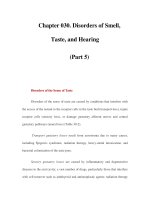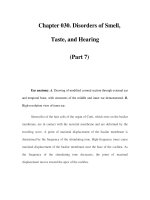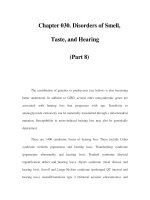Chapter 030. Disorders of Smell, Taste, and Hearing (Part 9) pdf
Bạn đang xem bản rút gọn của tài liệu. Xem và tải ngay bản đầy đủ của tài liệu tại đây (38.39 KB, 5 trang )
Chapter 030. Disorders of Smell,
Taste, and Hearing
(Part 9)
Disorders of the Sense of Hearing
Hearing loss can result from disorders of the auricle, external auditory
canal, middle ear, inner ear, or central auditory pathways (Fig. 30-4). In general,
lesions in the auricle, external auditory canal, or middle ear cause conductive
hearing losses, whereas lesions in the inner ear or eighth nerve cause
sensorineural hearing losses.
Figure 30-4
An algorithm for the approach to hearing loss. HL, hearing loss; SNHL,
sensorineural hearing loss; TM, tympanic membrane; SOM, serous otitis media;
AOM, acute otitis media; *, CT scan of temporal bone; t , MRI scan.
Conductive Hearing Loss
This results from obstruction of the external auditory canal by cerumen,
debris, and foreign bodies; swelling of the lining of the canal; atresia or neoplasms
of the canal; perforations of the tympanic membrane; disruption of the ossicular
chain, as occurs with necrosis of the long process of the incus in trauma or
infection; otosclerosis; or fluid, scarring, or neoplasms in the middle ear. Rarely,
inner-ear malformations may present as conductive hearing loss beginning in
adulthood.
Cholesteatoma, stratified squamous epithelium in the middle ear or
mastoid, occurs frequently in adults. This is a benign, slowly growing lesion that
destroys bone and normal ear tissue. Theories of pathogenesis include traumatic
implantation and invasion, immigration and invasion through a perforation, and
metaplasia following chronic infection and irritation. On examination, there is
often a perforation of the tympanic membrane filled with cheesy white squamous
debris. A chronically draining ear that fails to respond to appropriate antibiotic
therapy should raise suspicion of a cholesteatoma. Conductive hearing loss
secondary to ossicular erosion is common. Surgery is required to remove this
destructive process.
Conductive hearing loss with a normal ear canal and intact tympanic
membrane suggests ossicular pathology. Fixation of the stapes from otosclerosis is
a common cause of low-frequency conductive hearing loss. It occurs equally in
men and women and is inherited as an autosomal dominant trait with incomplete
penetrance. Hearing impairment usually presents between the late teens to the
forties. In women, the otosclerotic process is accelerated during pregnancy, and
the hearing loss is often first noticeable at this time. A hearing aid or a simple
outpatient surgical procedure (stapedectomy) can provide adequate auditory
rehabilitation. Extension of otosclerosis beyond the stapes footplate to involve the
cochlea (cochlear otosclerosis) can lead to mixed or sensorineural hearing loss.
Fluoride therapy to prevent hearing loss from cochlear otosclerosis is of uncertain
value.
Eustachian tube dysfunction is extremely common in adults and may
predispose to acute otitis media (AOM) or serous otitis media (SOM). Trauma,
AOM, or chronic otitis media are the usual factors responsible for tympanic
membrane perforation. While small perforations often heal spontaneously, larger
defects usually require surgical intervention. Tympanoplasty is highly effective
(>90%) in the repair of tympanic membrane perforations. Otoscopy is usually
sufficient to diagnose AOM, SOM, chronic otitis media, cerumen impaction,
tympanic membrane perforation, and eustachian tube dysfunction.
Sensorineural Hearing Loss
Damage to the hair cells of the organ of Corti may be caused by intense
noise, viral infections, ototoxic drugs (e.g., salicylates, quinine and its synthetic
analogues, aminoglycoside antibiotics, loop diuretics such as furosemide and
ethacrynic acid, and cancer chemotherapeutic agents such as cisplatin), fractures
of the temporal bone, meningitis, cochlear otosclerosis (see above), Ménière's
disease, and aging. Congenital malformations of the inner ear may be the cause of
hearing loss in some adults. Genetic predisposition alone or in concert with
environmental exposures may also be responsible.









